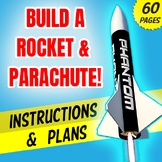415 results
11th grade astronomy laboratories
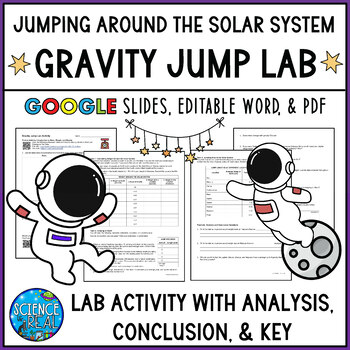
Gravity Lab - Weight, Mass, and Gravity Jump Lab Activity
⭐ ⭐ ⭐ ⭐ A classic fun lab activity made for secondary science students! Editable MS Word, PDF, and Google Slides versions included! Students learn mass, weight, and gravity and then calculate their weight and jump length at various locations in the solar system.⭐ This Lab is Broken Down Into 5 Different Tasks ⭐•Task 1- Pre-Lab: Students watch a short modern video about mass, weight, and gravity, and answer questions.•Task 2 - Weight On Other Planets: Student calculate their weight using the forc
Subjects:
Grades:
7th - 11th
Types:
NGSS:
HS-ESS1-4
, MS-ESS1-2
Also included in: Introduction Astronomy, Gravity, and Kepler's Laws GROWING BUNDLE
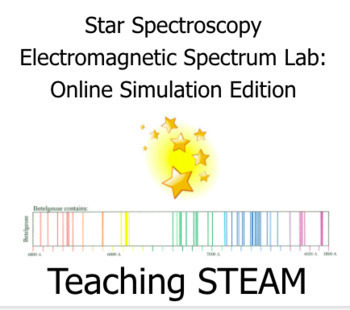
Star Spectroscopy/Electromagnetic Spectrum Lab: Online Simulation Edition
Spectroscopy is how we know what elements are in stars. This lab is awesome connecting students to how star science works. It also makes spectroscopy real in chemistry class, physics, astronomy, and general science about the electromagnetic spectrum. My students loved this activity solo and over Zoom. They felt that they learned how we use spectroscopy and have a deeper understanding of the electromagnetic spectrum. This activity is an online simulation version of Star Spectroscopy/Electromagnet
Subjects:
Grades:
9th - 12th
Types:
NGSS:
HS-ESS1-3
, HS-ESS1-1
, HS-ESS1-2
, HS-PS4-1
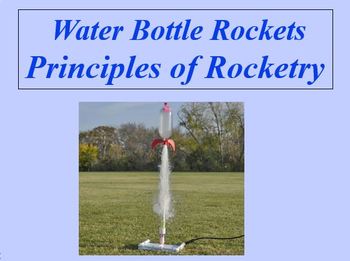
Water Bottle Rocket Launch Bundle
Want your students to study and launch water bottle rockets but need guidance? Well, I am here to help. The PowerPoint in this bundle will take your students through key vocabulary such as drag, ballast, thrust and discuss how Newton’s Three Laws affect the launch of a rocket. Day 1, students will work through the PowerPoint individually and design a water bottle rocket. Students will then join with a partner who also has a plan and merge their ideas into one design plan that they will build.
Subjects:
Grades:
5th - 12th, Higher Education
Types:
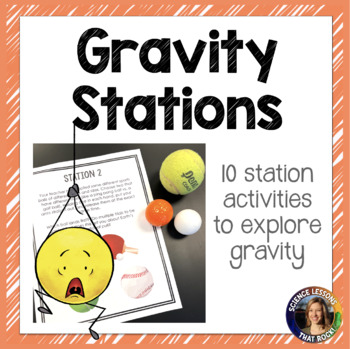
Gravity Station Activity
This station activity is designed to allow students to explore gravity and its impact on both Earth and the universe. It is not a deep dive into gravity and does not include calculations or space time. It is a fun way to introduce gravity before learning about coalescence and our solar system. Station 1: Students will use a PHET simulation to explore gravity and orbits. A laptop or tablet is required at this station. Station 2: Students will complete a ball drop experiment. Balls of different si
Subjects:
Grades:
9th - 11th
Types:
Also included in: The Universe and Stars Bundle

Tides Lab Using Water Balloons - Hands On Experience That Kids LOVE!
This lab is a really fun way to use discovery and investigation to teach students how gravity and inertia cause tides, along with the moon. The cost is low (a package of water balloons and yarn) and it is a great activity to get kids moving and outside. They work in small groups and go through a series of steps and procedures and record data. This was one of the most fun labs of the year for students and was instrumental is having kids understand why we have high tides on the side of the Earth c
Subjects:
Grades:
6th - 12th
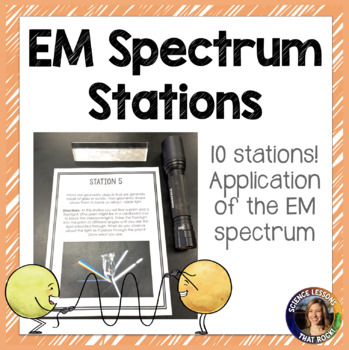
Electromagnetic Spectrum Station Activity
This station activity is designed to allow students to explore the electromagnetic spectrum and look at application of different wavelengths. This is a fun activity to add to your astronomy unit! Station activities included:Station 1: Students will use a PHET simulation to explore molecules and light. A laptop or tablet is required at this station. Station 2: Students will analyze an EM spectrum diagram and answer questions. Station 3: Students will observe X rays of bones and draw conclusions a
Subjects:
Grades:
9th - 11th
Types:
Also included in: The Universe and Stars Bundle

Kepler's Laws of Planetary Motion: ELLIPSE LAB - Loaded with FUN!
PROCEEDS BENEFIT CHARITY:
"REACH INC."-EMPOWERING ADULTS WITH DISABILITIES
http://www.reachinc.org
Come explore a beautiful marriage of both math and science. Experience Kepler's Laws of Planetary Motion like you never have before. In this dynamic ellipse lab, content and inquiry go hand in hand. This special creation is applicable to many ability and grade levels. This is lab is LOADED starting with Kepler’s 3 Laws. First, the law of ellipses. Second, the law of equal areas. Third, th
Subjects:
Grades:
6th - 12th
Types:
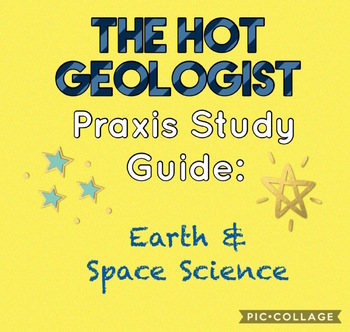
Earth Science Praxis Exam Study Guide
Need to get the extra certification to become more qualified? Say no more!
I made this study guide based on the PDF from the Praxis site: https://www.ets.org/s/praxis/pdf/5571.pdf
Includes all test specifications and sections needed to know for the exam!
> I passed for my state standards from studying this study guide I made! Good luck, studying one page a day helps!
MY STUDY TIPS:
• Study every day.
• Study a page a day, and also go back to old material to refresh.
• Pick a time of
Subjects:
Grades:
7th - 12th
Types:
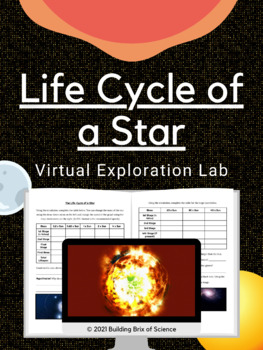
Life Cycle of a Star Virtual Exploration Lab
What are the stages of a star's life? In this virtual lab, students will use mathematical data to analyze the life cycles of different stars based on their initial mass. Students will also:⚗️Test their Pre-Existing Knowledge of Stars⚗️Analyze the Fusion of Hydrogen Atoms into Helium⚗️Explain the Correlation between a Star's Mass and its' Age⚗️Investigate the Formation of Neutron Stars & Black HolesNOTE: This activity links to the Star in the Box Simulation from Las Cumbres University. Check
Subjects:
Grades:
6th - 12th
Types:
NGSS:
HS-ESS1-3
, HS-ESS1-1
Also included in: Virtual Science Labs Full Exploration Activity Bundle

The Doppler Effect - Evidence for the Big Bang Theory | Digital Lab Activity
In this Google Slides™ digital lab activity, the students will learn how the Doppler effect is used to measure the movement of galaxies and stars in space and why the redshift in the light from distant galaxies is one of the pieces of evidence for the Big Bang Theory. The students will analyze light spectra from galaxies and stars. They will notice a pattern in the relationship between the position of the absorption lines with respect to the red end of the electromagnetic spectrum and the distan
Subjects:
Grades:
8th - 11th
Types:
CCSS:
NGSS:
HS-ESS1-2
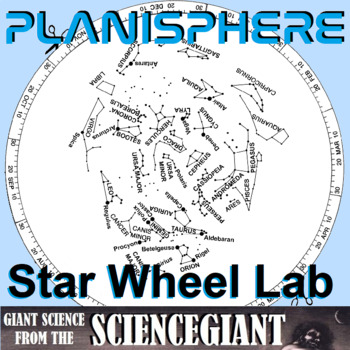
Planisphere Lab Activity: A Star Wheel for Constellation Exploration
Inexpensive and ingenious! Planispheres are a unique tool for learning astronomy: a make-it-yourself star map, adjustable for any time of night in any month of the year. They are designed to show the position of prominent constellations in the night sky. It's a low-tech way for Ss to learn the location (and thus give meaning to key vocabulary terms) of the horizon, zenith, meridian, ecliptic and celestial equator on the celestial sphere. This lab includes two types of planispheres: one for stan
Subjects:
Grades:
6th - 12th, Higher Education
Types:
NGSS:
HS-ESS1-4
, 5-ESS1-2
, MS-ESS1-1
Also included in: StayGiant Earth Science Bundle: Astronomy (space exploration)

Star Nuclear Fusion Lab
In this lesson, students will build models that show how stars fuse hydrogen in the core and release energy. There are 2 versions included:1. MIDDLE SCHOOL VERSION: In this version, students will model the fusion of protons only. They will use white mini-marshmallows to show the fusion of hydrogen all the way up to iron (where fusion stops). 2. HIGH SCHOOL VERSION: In this version, students will model the fusion of protons and neutrons. They will use white mini-marshmallows as protons, colored m
Subjects:
Grades:
9th - 11th
Types:
NGSS:
HS-ESS1-3
Also included in: Stars Bundle
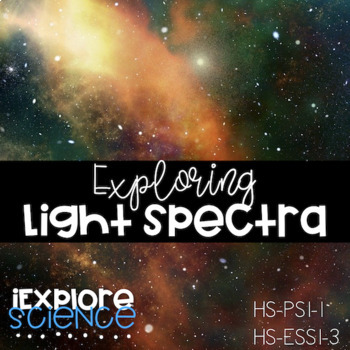
Exploring Light Spectra - Spectroscope Lab (HS-ESS1-3, HS-PS1-1)
Launch a storyline into stars, the universe, and matter and energy in space by investigating the sun's spectrum and exploring what we can learn about our star by understanding it. This bundle includes three activities to guide students through an abbreviated 5E sequence (the engage, explore, and explain phases).Phenomenon: Fraunhofer Lines Engage Students will observe the sun's spectrum and ask questions about the dark lines that can be observed. Exploring Light With Spectroscopes* Explore Stu
Subjects:
Grades:
9th - 12th
Types:
NGSS:
HS-PS1-1
, HS-ESS1-3
, HS-ESS1-1
Also included in: Evidence For The Big Bang Theory BUNDLE - HS-ESS1-2
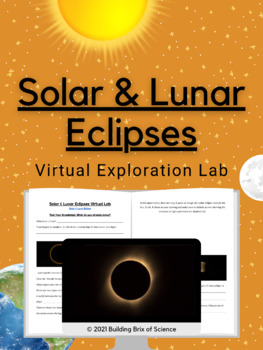
Solar & Lunar Eclipses Virtual Exploration Lab
What is the difference between a Solar and Lunar eclipse? In this virtual lab, students will manipulate the Earth & Moon to determine what causes an eclipse. Students will also:⚗️Test their Pre-Existing Knowledge of an Eclipse⚗️Identify the Lunar Phases that occur during Eclipses⚗️Draw Diagrams of a Solar & Lunar Eclipse⚗️Compare & Contrast Partial and Total EclipsesNOTE: This activity links to the free Interactive from Earth Space Lab. Check it out below!Solar & Lunar EclipsesPu
Subjects:
Grades:
6th - 12th
Types:
NGSS:
MS-ESS1-1
Also included in: Virtual Science Labs Full Exploration Activity Bundle

Radioactive Decay Lesson Plan
The purpose of this 75-minute lesson is to help middle school and high school students understand that radioactive decay is the tool used by scientists to find the age of very old objects. While it is dangerous and nearly impossible to do a lab on radioactive decay, this activity is a ★fantastic alternative★!----------------------------------------------------For this activity students will:☆Take-notes with the aid of a PowerPoint and a student Graphic Organizer☆Use a hands-on activity with M&am
Subjects:
Grades:
8th - 12th
Types:
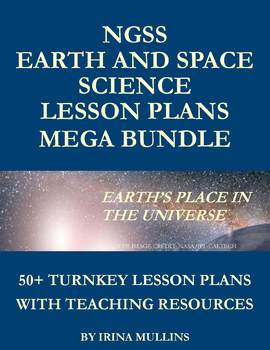
NGSS Earth and Space Science Lesson Plans MEGA BUNDLE: 50+ Turnkey Lesson Plans
This Mega Bundle is a NGSS-designed Earth and Space Science curriculum.***** GIFT WITH PURCHASE: Download the preview file to view information about your gift with purchase. *****This curriculum meets the NGSS High School Earth and Space Science performance expectations and covers the NGSS High School Earth and Space Science disciplinary core ideas in ESS1: Earth’s Place in the Universe. The curriculum includes a space science textbook (astronomy textbook), Test Bank with more than 1,000 questio
Subjects:
Grades:
6th - 12th
Types:
NGSS:
HS-ESS1-6
, HS-ESS1-4
, HS-ESS1-3
, HS-ESS1-5
, HS-ESS1-1
...
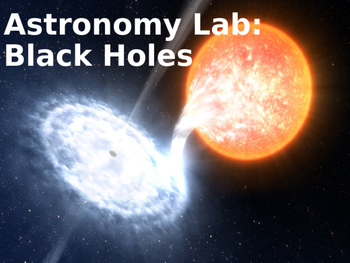
Astronomy Lab Activity: Black Holes
In this lab activity, students will study black holes by creating their own. Students create the collapsing core of a supernova, which they use to determine the radius of the event horizon of their "tin foil black hole". Answer key is included.
Subjects:
Grades:
10th - 12th
Types:
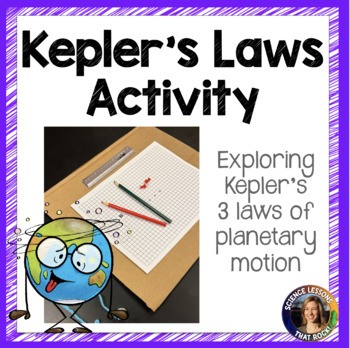
Kepler's Laws of Planetary Motion Activity
In this activity, students will model Kepler's 3 laws of planetary motion. They will calculate the eccentricity and orbital velocity of the ellipses they draw, and then model orbital velocity with a washer and string. Each group will need: a piece of cardboard, 2 thumbtacks, a ruler, 2 colored pencils, string, 2 washers, and a straw. Check out the preview for more details.Included in your purchase:- 3 page student worksheet- Teacher directions- Answer keyThis PDF is not editable.You might also b
Subjects:
Grades:
9th - 11th
Types:
NGSS:
HS-ESS1-4
Also included in: Solar System Bundle

Cosmic Calendar
Based on Carl Sagan's "Cosmos", the Cosmic Calendar is a model that compares the 13.8 billion year history of the universe to a single calendar year. In the Cosmic Calendar, January 01 represents the Big Bang, and December 31 represents "now." In this model, the earth and sun appear around the beginning of September. In this activity, students will be able to construct a poster of the Cosmic Calendar. They will compute the Calendar dates for major events in the history of the universe, and they
Subjects:
Grades:
11th - 12th
Types:
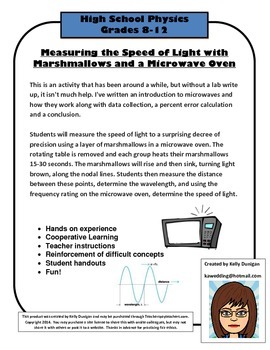
Measuring the Speed of Light: Marshmallows and Microwaves
This is an activity that has been around a while, but without a lab write up, it isn't much help. I've written an introduction to microwaves and how they work along with data collection, a percent error calculation and a conclusion.
Students will measure the speed of light to a surprising decree of precision using a layer of marshmallows in a microwave oven. The rotating table is removed and each group heats their marshmallows 15-30 seconds. The marshmallows will rise and then sink, turning
Subjects:
Grades:
7th - 12th, Higher Education
Types:
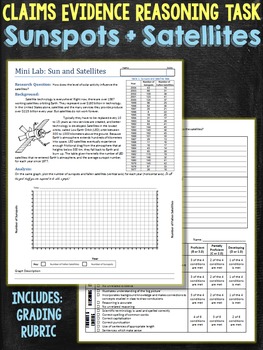
Lab Activity Effect of Sunspots on Satellites (Claims Evidence Reasoning Task)
A short lab activity for astronomy or earth space science. Students make a double line graph of the number of sunspots and the number of crashed satellites in a given year. Then they look for patterns and write a science conclusion utilizing claim, evidence, reasoning scaffolding framework.
Grading rubric and sample student responses are included
This lab activity blends well into a unit on electromagnetic waves, planetary mechanics, or the Sun's influence on Earth.
Subjects:
Grades:
7th - 12th, Higher Education
Types:
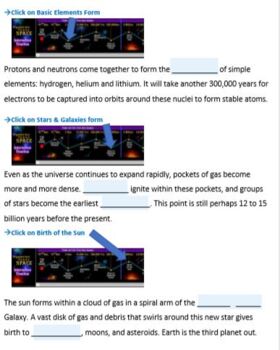
Big Bang Evidence: Red Shift - Virtual Lab Simulation
NO FLASH NEEDED! Students will explore the early steps of the Big Bang and then prove the Universe is expanding by manipulating the light of a galaxy moving away from or towards Earth. This virtual lab is excellent for remote or in-class laboratory exploration. The virtual lab simulation worksheet contains auto-fill in blanks, so no annotation software is needed. The links for the free sites used are located within the lab.
Subjects:
Grades:
6th - 11th
Types:
CCSS:
NGSS:
MS-ESS1-4
, MS-ESS1-2
, MS-ESS1-3
, HS-ESS1-2
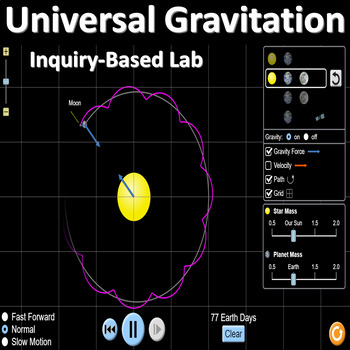
Universal Gravitation and Orbits Inquiry Lab (Phet Simulation) | Physics
This is a simple inquiry-based lab that I love to give students as an intro to Universal Gravitation. Students will figure out for themselves conceptual problems involving Universal Gravitation. They will get the basic idea of how Universal Gravitation works while discovering mind-blowing concepts, such as how the mass affects the gravitational pull on different objects. Lastly, the last page of the lab also includes calculations for students who have been introduced to the math portion of Unive
Subjects:
Grades:
7th - 12th, Higher Education
Types:
NGSS:
HS-PS2-1
, HS-PS2-4
Also included in: HIGH SCHOOL PHYSICS | Entire Year Lab Bundle | NGSS Curriculum
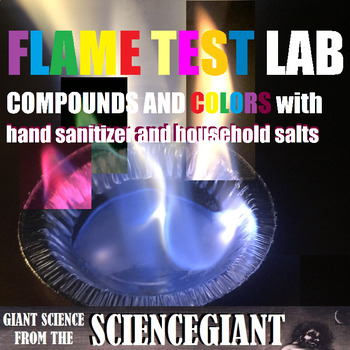
Flame Test Lab of Compounds and Colors with hand sanitizer and household salts
Flame Test of Compounds and Colors is a low cost lab demonstration to fire up your students. This chemistry lab uses hand sanitizer and household chemicals of sodium chloride (table salt), potassium chloride (salt substitute), sodium borate (insecticide with borax acid) and potassium hydrogen tartare (cream of tartar) in a safe and fun fiery introduction to compounds! Excite electrons and ignite your students interest in elements with this demonstration of red, orange, yellow, green, blue, and p
Subjects:
Grades:
7th - 12th
Types:
NGSS:
HS-PS4-1
, HS-PS4-3
Showing 1-24 of 415 results



